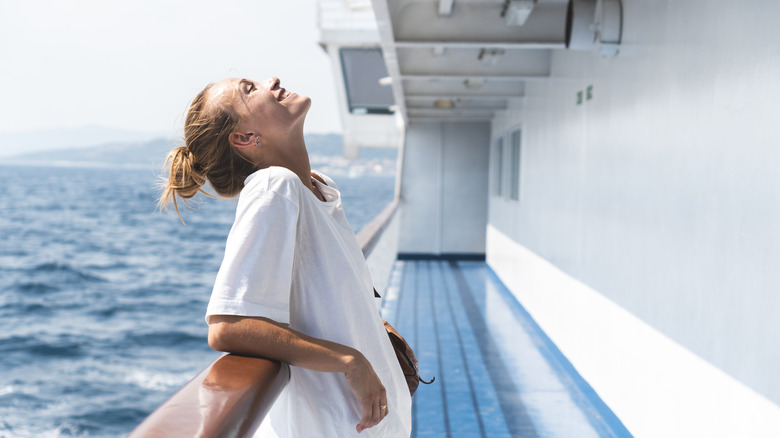Avoid Cruises That Pass Through These Rough Seas If You're Worried About Sea Sickness
Getting sick on vacation is never fun. Whether it's getting food poisoning from dodgy street vendors or catching a cold while exploring a foreign city, few things can put a damper on your travel plans like an unexpected illness that lands you in bed for days. However, out of all the ailments and bugs out there, there's one specific condition that takes the crown when it comes to ruining vacations: getting seasick on a cruise.
Awful physical symptoms aside, seasickness on a cruise can be particularly frustrating — especially considering you're basically confined to the ship for days or weeks at a time, with no way to actually escape what's making you ill. All of which is made worse when the constant swaying and rolling motion can trigger nausea, dizziness, and headaches that make your dream vacation feel like a nightmare.
So which cruises generally get the worst rap? Well, out of all the major sailing journeys, it's the North Atlantic routes that tend to claim the most seasickness victims due to their boat-rocking, choppy waters. You're also going to want to be careful about when you cruise in the Caribbean and Gulf of Mexico. Luckily, though, there are still plenty of other options out there — did someone say Mediterranean cruise? — that can help you avoid the rough seas and, instead, enjoy some smooth sailing (hopefully literally) on your next seafaring vacation.
Avoid the North Atlantic if you're worried about getting seasick
In most cases, North Atlantic cruise routes — most of which have a notorious reputation for navigating through rough waves and feature a stormy environment year-round — are generally regarded as both challenging and unpredictable for travelers who tend to suffer from motion sickness (and even those who don't). This is especially true for areas like the Bay of Biscay. Located between France and Spain, this region combines all of the worst elements for a cruise experience: powerful winds, varying ocean depths, and frequent storms. Throw them together, and these factors can easily lead to consistently rough conditions that have proven to be especially challenging for cruisers who aren't used to dealing with the motion of the ocean.
That said, planning your cruise route strategically can help make a significant difference in how much movement you feel at sea. As a general rule, the Mediterranean Sea typically offers some of the calmest waters for cruising — mostly due to its typically mild weather patterns. This ultimately makes it an excellent choice for travelers who are prone to getting a little queasy. In the same vein, you'll find similarly peaceful conditions in the Gulf of Mexico, where the surrounding landmasses help protect cruises from passing through too rough seas.
However, no matter where you're sailing from, timing is also key. For Mediterranean cruises, you'll want to try and plan your trip between April and September (or early October at the latest) when there's the least chance of rain or unexpected storms. Alternatively, if you're dreaming of a Caribbean or Gulf of Mexico cruise, make sure to book your trip outside the hurricane season — which runs from June through November — to avoid choppy waters and storms that could leave you holding onto the toilet bowl for the duration of your trip.
Other ways to prevent seasickness aboard a cruise
The thing about weather is that it can oftentimes be unpredictable — which means there's no real guarantee that you'll find only calm seas and smooth sailing during your cruise. That said, there's also no reason for you to fear seasickness enough to start doubting your itinerary or, worse, miss out entirely.
Fortunately, most modern cruise ships nowadays offer several ways to minimize motion sickness. For one, the best cabin location to book on your next cruise if you are prone to seasickness is typically in the middle of the ship, since it's less likely to rock. Additionally, you'll also want to book a cabin on a lower deck, where the ship's motion is less noticeable as well. Finally, having a cabin with a balcony also gives you quick access to fresh air, which can help ease nausea symptoms as soon as they strike.
For medication, there's always Dramamine — an over-the-counter antihistamine that helps prevent and treat motion sickness by blocking signals in your inner ear that trigger nausea. And when all else fails — yes, even Dramamine — there's another handy medicine that most cruisers swear by to fight seasickness: cinnarizine. Unfortunately, though, cinnarizine isn't available in the U.S. — which means you might have trouble finding it unless you've stopped in Mexico or Europe beforehand.


